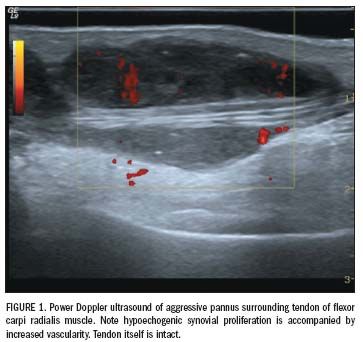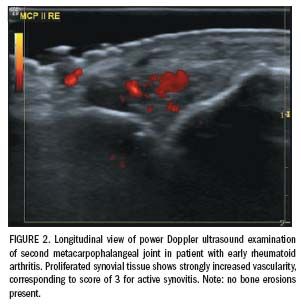Modern sonographic methods improve arthritis work-up
Rheumatoid arthritis is a chronic and progressive inflammatory disease of the joints. It affects approximately 1% of the general population, with incidence being three times higher in women than men.
Rheumatoid arthritis is a chronic and progressive inflammatory disease of the joints. It affects approximately 1% of the general population, with incidence being three times higher in women than men. The areas most commonly involved are the metacarpophalangeal joints, the proximal interphalangeal joints, and the feet.
Small-parts ultrasound has become increasingly important for the early diagnosis of rheumatoid arthritis. Clinical findings, including swelling and joint tenderness, can be supported by an ultrasound examination that documents the characteristic pattern of inflammation.

Early stages of disease primarily affect the synovium. Acute synovial inflammation (synovitis) is characterized by increased synovial vascularity (neoangiogenesis) and is regarded as a predictive marker of erosive progression.1,2 The chronic inflammatory process causes synovial proliferation and the development of the aggressive pannus that can undermine articular cartilage and cause irreversible erosions at the osteochondral junction (bare areas). Adjacent structures, such as the capsule, cartilage, ligaments, tendons (Figure 1), and adjacent bone, become involved during the course of the disease.
Synovitis appears to be the best predictive marker of future damage. An early diagnosis of rheumatoid arthritis coupled with an assessment of the extent of pre-erosive inflammatory features is consequently important to a good clinical outcome. New biological, disease-modifying anti-rheumatic drugs can suppress disease activity and joint destruction. Therapeutic advances such as this put pressure on diagnostic imaging to provide an accurate and prompt diagnosis, as well as adequate monitoring of disease progression.
Conventional radiography should be performed initially in each patient to assess the baseline joint status. This will permit further rheumatic changes to be evaluated in context and allow confirmation of a suspected diagnosis. We should keep in mind, however, that radiography has lower diagnostic value than ultrasound and MRI for the determination of acute inflammation. It will depict only indirect signs of cartilage loss, such as joint space narrowing and bony erosions due to previous destructive synovial inflammatory activity. A further drawback is length of time required for erosions to become visible on radiography. Signs of destruction seen on ultrasound and MRI may not become visible on plain film x-ray images for up to a year.
ULTRASOUND ADVANCES
Technical developments, namely the use of high-frequency transducers of 10 MHz or higher, have improved the spatial resolution of ultrasound images. High-resolution ultrasound can now depict 20% more erosions than radiography can.3

Color Doppler and power Doppler ultrasound are useful ways of assessing synovial inflammation. These methods show vascular signals in active synovitis, depending on the degree of inflammation (Figure 2). The use of gray-scale ultrasound to visualize hypoechogenic or hyperechogenic synovium can lead to an unacceptably high number of healthy joints being interpreted as pathological.4 The use of Doppler ultrasound tools may help to reduce this pitfall given that hypervascularization is not observed in nonpathologic joints.
A possible problem with Doppler ultrasound is the risk of false-positive hypervascularization observations. This can happen when the color gain setting on the ultrasound machine is inappropriately high, producing a “blooming” effect on images that is misinterpreted as hypervascularization. To avoid this, the color gain should be set so that the metacarpophalangeal vessels are visible and the threshold level is just above the level of noise. Motion artifacts can also lead to blooming on Doppler ultrasound images.
The use of a semiquantitative score for synovitis that ranges from 0 to 3 is practical for routine work3:
• Grade 0: No additional flow except in the dorsal metacarpophalangeal vessels.
• Grade 1: Slightly increased vascularization in single vessels.
• Grade 2: Moderately increased vascularization in confluent vessels that cover less than half of the synovium.
• Grade 3: Strongly in-creased vascularization in confluent vessels that cover more than half of the synovium.
Several studies have shown that changes in synovial inflammation induced by therapy can be detected reliably with power Doppler ultrasound. This imaging technique is consequently regarded as a useful adjunct to radiography and grayscale ultrasound in the assessment of rheumatoid arthritis and the evaluation of treatment response.1,5-7
Microbubble contrast agents that have a diameter of 2 to 8 microns and access the capillaries can increase the strength of reflected ultrasound signal from blood. Harmonic imaging methods are preferred to maximize the contraction and expansion of the microbubbles.
Pulse-inversion harmonic imaging cancels the linear background tissue signal and improves the discrimination between small vessels and soft tissue.8 Two reciprocal ultrasound waves are transmitted in sequence into the tissue to subtract the linear signal from the background tissue. Linear signals from tissue are thereby cancelled out.9 Signals produced by the nonlinear oscillations of bubbles are slightly out of phase and do not cancel. The detected signal is based on second harmonic waves generated from the nonlinear oscillation of bubbles and stimulated acoustic emission effects from the destruction of bubble walls.10

It is possible to make an objective measurement of the inflammation when using pulse-inversion harmonic imaging. This is done by calculating the area under the “echo intensity time” curve after the contrast injection (Figure 3).7,11 Active inflammation, as indicated by the number of small vessels, will be directly proportional to the increase in echo intensity. Investigators should, however, ensure that the transducer does not move during the dynamic contrast-enhanced ultrasound examination, as the region of interest should match exactly the region set in the previous image. A low mechanical index, of 0.1 or less, should ensure optimal and long-lasting echo intensity.
MRI AS ADJUNCT
MRI should be regarded as a complementary diagnostic method to ultrasound in this application, and the method of choice for detecting the bone marrow edema that occurs in early rheumatoid arthritis. The sensitivity and accuracy of ultrasound compared with MRI in detecting synovitis and erosions has been discussed in the literature, with different authors reaching different conclusions.12,13
Some studies have reported that thin-slice, high-field MRI is more sensitive than ultrasound for the detection of synovitis. Concerns have also been raised about the specificity of MRI, despite its acceptance as a gold standard. These worries relate to the appearance of partial-volume artifacts on MRI and/ or regions of focal bone marrow edema that can mimic erosions.
Ultrasound- and MR-based assessments of synovial inflammation generally correlate closely,12,14 and power Doppler imaging has a high sensitivity to the detection of increased blood flow. Power Doppler and modern ultrasound modalities are regarded as suitable bedside tools for the assessment of synovitis, hence for the diagnosis and management of rheumatoid arthritis.15,16
MRI examinations are time-consuming and costly, and systems are not widely available in all countries. Imaging is also limited by the quality of and access to MRI coils. We consequently prefer ultrasound to MRI for routine diagnostic use.
In conclusion, the detection of synovitis and its response to therapy has a strong influence on clinical outcome. Quantification of synovial inflammation is thereby necessary to control and support therapeutic decisions made by rheumatologists.
In light of rapidly evolving imaging techniques, such as MRI and ultrasound, the quantification of post-treatment changes to synovial vascularization has gained in importance in assessing rheumatoid arthritis.
Objective, computer-aided techniques will replace time-consuming and tedious scoring methods in the future, saving time and resources. Research efforts should focus on the development of easy-to-handle, automated, computer-assisted methods, and clinicians should aim to implement these new techniques in daily clinical practice.
New AI-Enabled Portable Ultrasound May Facilitate 50 Percent Reduction in Cardiac Imaging Scan Time
March 28th 2025Artificial intelligence (AI)-powered measurement capabilities provide key features with the Compact Ultrasound 5500CV device, which was unveiled at the American College of Cardiology (ACC) conference.
The Reading Room: Racial and Ethnic Minorities, Cancer Screenings, and COVID-19
November 3rd 2020In this podcast episode, Dr. Shalom Kalnicki, from Montefiore and Albert Einstein College of Medicine, discusses the disparities minority patients face with cancer screenings and what can be done to increase access during the pandemic.
Can Ultrasound-Based Radiomics Enhance Differentiation of HER2 Breast Cancer?
March 11th 2025Multicenter research revealed that a combined model of clinical factors and ultrasound-based radiomics exhibited greater than a 23 percent higher per patient-level accuracy rate for identifying HER2 breast cancer than a clinical model.